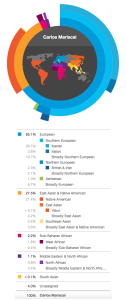Given the recent series in the New York Times about the problem of homogeneity in philosophy, I’ve decided to post a brief statement about diversity here. Further resources can be found elsewhere.
I recommend What We’re Doing About What It’s Like for uplifting information, Map the Gap for information on how to change it, What it is like to be a woman/person of color in philosophy or for horror stories, and the APA committee on women for official statements. There’s also a useful online resource of readings done by women in philosophy and a set of resources on the matter by the APA.
Progress in this area of philosophy has fallen behind many other related disciplines. As those links point out, there are fewer Latinos, black people, and women in professional philosophy than in nearly every other major area of academic study. We also do very poorly in representing people from historically low socioeconomic status and from rural parts of the country. These issues matter to us as a discipline for a variety of reasons. First, differences in experience and approach can generate new ideas; second, if this is an institutional problem, it is immoral to continue; and lastly, is bad from pragmatic point of view to lose women and minorities in pipeline.
It is likely a fruitless task to assign blame, but there are plenty of solutions. The links provided above suggest many straightforward approaches. Less well represented in these approaches is what to do about Latino, black, and poor students. As this chart shows, we’re doing equally bad in other areas. Less than 20 percent of philosophers are women, but only two percent of philosophers in this country are black or Latino. It surprises me that while Latinos are the largest minority in the United States, they have proportionately the lowest educational attainment. According to the most recent census, only 13.9 percent of Latinos graduate college as compared to the national average of 29.9. We obviously need to have a conversation as a discipline and actively try to fix this gap.
Because many of my formative years were spent below the poverty line I am particularly sensitive to the issue of students feeling alienated or under-prepared. My parents suffered two economic depressions in Mexico before they moved to this country. It wasn’t until I was in middle school that my father was able to earn more than minimum wage and we were able to afford a house with multiple bedrooms. I never would have considered this an important part of my upbringing until I came to Duke and found my perspective heavily underrepresented. I have never had a Latino professor, which seems absurd since I did my undergraduate work in a town with a population that was 56.8% Hispanic. This isn’t a trivial point– I never considered graduate school until a close friend of mine began applying to schools and actively encouraged me to do so as well. I didn’t consider a career in academia until after I graduated, largely because, aside from one professor who had been raised New Mexico, I never identified with any of my instructors.
There are things we can all do to help. For instance, in each of my classes I’ve incorporated at least a quarter of the readings from female philosophers. I’ve also included philosophers I know are from minority backgrounds and from other disciplines or countries. In the classroom, I am careful to be particularly encouraging to students that would fall silent in typical classes. I break up the learning dynamic regularly. If a student is too shy to contribute in a large group, I occasionally make my classes split up into smaller groups to alleviate the pressure. I never ask questions with determinate answers, so students never feel pressured. Each of my questions, instead, varies between practical questions to highly theoretical ones– allowing for input from every walk of life.
I’m sure there’s much more I can do. For example, I used to advocate classes that relied on all and only primary sources. But one year in an intro class, I had a student from Peru and a student from Colombia who were probably the most engaged, motivated students I’ve ever had. They struggled with the reading all semester until I finally understood that the readings I was assigning (Hume, Mill, Kant, etc.) were actively impeding my students’ ability to learn the material. So now, in the hopes of having readings that augment– rather than detract from– my class activities, I assign textbooks in my intro classes. I care about getting them to think critically, and that is more likely to happen if they can understand the reading. The moral of the story is that the job is never done. I thought my class was as inclusive as it could have been, but I never thought to imagine what it must like the perspective of English as second language student, which is bewildering, because at some point, English was second language. So now I strive to keep an open mind and see how my approach can be improved. Even with constant vigilance, unjust systems can slip by attention, but it doesn’t hurt to try.
Diversity and inclusiveness in discipline is not passing fad, it fundamental shift in world view.
